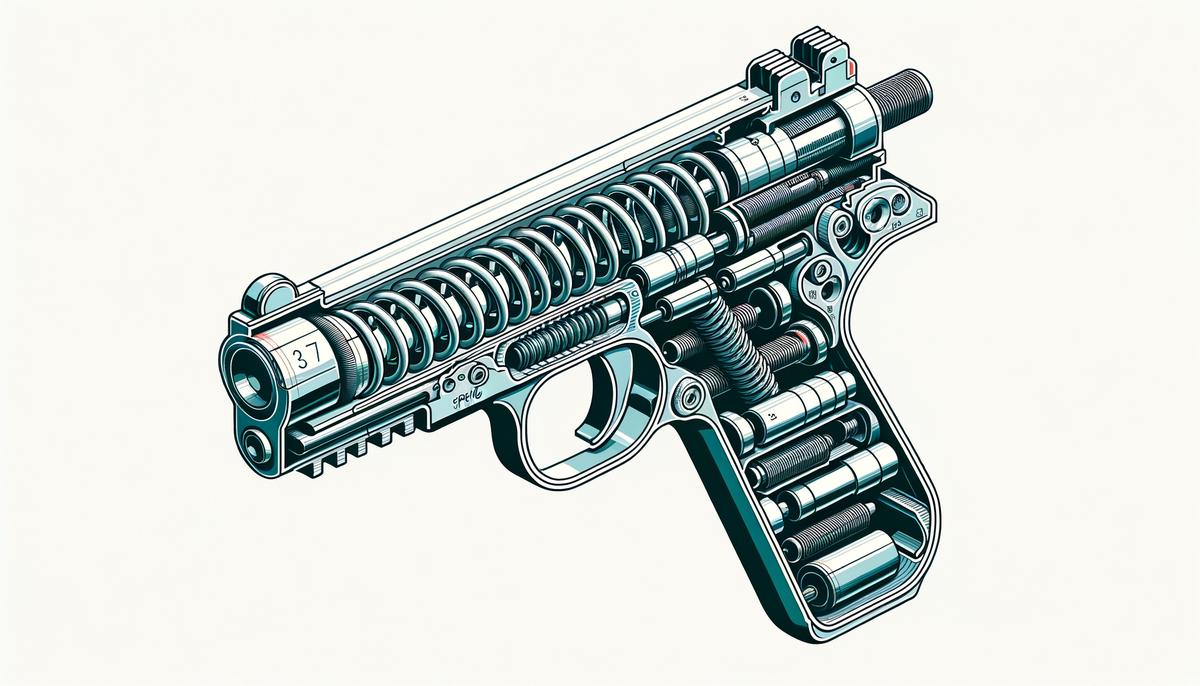Spring Piston and Nitro Piston Air Guns
Spring piston air guns use a coiled spring inside the chamber. Cocking the gun compresses the spring, which is released by the trigger. This propels a piston forward, compressing air and driving the pellet out of the barrel. These guns are popular for their simplicity and reliability.
Spring pistons need only pellets to operate. However, the recoil can affect accuracy, especially for new shooters. The "artillery hold" technique, which involves holding the gun gently and allowing it to recoil naturally, can improve consistency.
Nitro piston air guns use a gas-filled cylinder instead of a coiled spring. When cocked, the gas compresses and releases to drive the piston. They are generally quieter and have less recoil than spring pistons, making them popular for backyard shooting.
Nitro piston guns can stay cocked for long periods without losing power and offer more consistent performance over time. For example, the Crosman F4 with Nitro Piston technology provides reduced noise and vibration, making it user-friendly for newer shooters.
While spring pistons tend to be cheaper initially, nitro pistons offer reduced noise, smoother shooting, and longevity. Your choice between the two will depend on your budget and shooting preferences.

Pre-Charged Pneumatic (PCP) and CO2-Powered Air Guns
Pre-Charged Pneumatic (PCP) air guns use a reservoir filled with high-pressure air, typically around 2,000 to 4,500 psi. This reservoir can shoot multiple rounds before needing a refill. PCP guns offer consistent accuracy and power with minimal recoil, making them ideal for longer shooting sessions and serious applications.
PCP guns require an external source to refill the reservoir, such as hand pumps, scuba tanks, or specialized compressors. While the initial investment can be costly, their performance is unmatched. The Benjamin Marauder is an example of a PCP gun that combines sturdy design with exceptional performance.
CO2-powered air guns use carbon dioxide cartridges as their power source. These guns are easy to use and maintain, making them popular for casual shooting or plinking. However, their performance can vary with temperature, and they generally produce less power compared to PCP guns.
The Crosman Powerlet demonstrates the ease of use and reliability of CO2-powered air rifles, making them suitable for beginners or those seeking an uncomplicated shooting experience.
Choosing between PCP and CO2 air guns depends on your primary shooting activity. PCP guns are better suited for high-stakes hunting or precision target shooting, while CO2 air guns are more convenient for casual plinking or backyard shooting.

Factors to Consider When Choosing a Pellet Gun
When selecting a pellet gun, consider the following factors:
- Caliber: Common calibers are .177, .22, and .25. The .177 caliber is ideal for target shooting, while .22 is preferred for small game hunting. The .25 caliber offers greater stopping power but comes with higher ammunition costs.
- Power: Measured in foot-pounds (ft-lb), power requirements vary by use. For backyard plinking, under 12 ft-lb is sufficient. Small game hunting requires at least 16 ft-lb, while high-powered options exceeding 20 ft-lb are suitable for medium-sized game or pest control.
- Accuracy: Look for features that enhance accuracy, such as adjustable triggers, quality barrels, and precision sights or scopes. PCP air guns generally offer superior accuracy due to minimal recoil and consistent air delivery.
- Noise Level: Consider your shooting environment. Nitro piston and many PCP air guns often come with integrated suppressors or shrouded barrels to minimize noise, making them suitable for backyard use or areas with noise restrictions.
- Ergonomics: The weight, balance, and overall feel of the gun should match your physique and shooting style. Adjustable features like cheek rests, combs, and butt pads can help achieve a more personalized fit.
- Intended Use: Match the gun to your primary activity. For hunting, consider a powerful and accurate PCP rifle. For backyard plinking, a lower-powered and quieter CO2-powered gun might be more appropriate. For versatile pest control, look for options that balance power, accuracy, and ease of use.
By weighing these factors against your specific needs, you can find a pellet gun well-suited to your requirements and ensure a rewarding shooting experience.
Revolutionize your content with Writio: an AI content writer that creates high quality articles for your site. This article was written by Writio.
- Cardew G, Cardew G. The Airgun from Trigger to Target. G&G Publishing; 1995.
- Haendel W. Air Guns: The Complete Guide to Pellet, BB, and Toy Guns. Stackpole Books; 2006.
- Muramatsu K. The Encyclopedia of Airguns. Airgun Designs Inc; 1991.
Leave a Reply